February 2013
Sat 2nd: The Story So Far (4)
Wed 6th: Keeping the Edge
Wed 13th: BTTER I
Fri 15th: BTTER II
Tues 19th: BTTER III
Wed 27th: For Whom A Bell Tolls
Thurs 28th: See-saw
Sat 2nd: The Story So Far (4)
Division 1
| H C Kings
| 5
| 4
| 0
| 1
| 8
| | Stafford A
| 3
| 2
| 1
| 0
| 5
| | Cheddleton A
| 3
| 1
| 1
| 1
| 3
| | Newcastle A
| 4
| 1
| 0
| 3
| 2
| | Alsager A
| 3
| 0
| 0
| 3
| 0
|
|
Division 2
| Cheddleton C
| 6
| 5
| 1
| 0
| 11
| | Cheddleton B
| 6
| 3
| 2
| 1
| 8
| | Newcastle B
| 6
| 4
| 0
| 2
| 8
| | H C Knights
| 7
| 3
| 0
| 4
| 6
| | Macclesfield
| 7
| 1
| 1
| 5
| 3
| | H C Rooks
| 6
| 0
| 2
| 4
| 2
|
|
January started well, with all fixtures in the first week and a half played. Then the weather struck, and in a fortnight nine matches had been added to the postponed list. The scheduled division five jamboree was also in one of the off weeks, but it is hoped to be able to rearrange this to close to or just after the end of the season.
With just one match played in division one in which top beat bottom there is little to discuss there.
Cheddleton C extended their league at the top of division 2, and must now be regarded as favourites for the title, with attention now switching to the battle for the runners-up spot which appears a private affair between the B teams of Cheddleton and Newcastle. Macclesfield picked up their first win of the season at the expense of Newcastle, moving above Rooks at the bottom of the table in so doing.
Division 3
| Cheddleton E
| 11
| 6
| 2
| 3
| 14
| | Newcastle D
| 11
| 4
| 3
| 4
| 11
| | Cheddleton D
| 10
| 5
| 1
| 4
| 11
| | Kidsgrove
| 10
| 4
| 3
| 3
| 11
| | Fenton A
| 10
| 4
| 2
| 4
| 10
| | Stafford B
| 8
| 5
| 0
| 3
| 10
| | Meir A
| 11
| 4
| 2
| 5
| 10
| | Alsager B
| 10
| 5
| 0
| 5
| 10
| | Newcastle C
| 11
| 3
| 2
| 6
| 8
| | H C Pawns
| 10
| 3
| 1
| 6
| 7
|
|
Division 4
| Cheddleton F
| 9
| 6
| 3
| 0
| 15
| | Cheddleton G
| 8
| 5
| 2
| 1
| 12
| | Fenton B
| 7
| 5
| 2
| 0
| 12
| | Alsager D
| 11
| 4
| 4
| 3
| 12
| | Meir B
| 10
| 4
| 2
| 4
| 10
| | Alsager C
| 9
| 3
| 3
| 3
| 9
| | Meir C
| 9
| 3
| 2
| 4
| 8
| | Fenton C
| 9
| 2
| 2
| 5
| 6
| | Newcastle E
| 10
| 1
| 2
| 7
| 4
| | H C Tiny Pawns
| 10
| 1
| 2
| 7
| 4
|
|
Despite the weather their was plenty of action in the third division, with all teams managing at least two matches and with the exception of Kidsgrove picking up at least two points. Cheddleton D were the big movers, their five points from three games oving them from the lower half of the table into a tie for second place. Whilst one might say the battle is now between Cheddleton E who have points on the board, and Stafford B who have games in hand, in truth it is only the bottom two teams who probably feel out of the title hunt for the others are so tightly packed that a run of wins could catapult any of the rest to the top.
Cheddleton F continue to set the pace at the top of the fourth, though Cheddleton G and Fenton B remain in challenging positions. It is Alsager D however who would win the league's team of the month prize if such existed, their three wins in the month doubling heir points tally for the season. I suspect however that they areunlikely o be able to progress further into a medal position. At the other end of the table Newcastle E and the Tiny Pawns drew, thus failing to add clarity to the race to avoid the wooden spoon.
The second heat of the strong players GP was held during the month, with Rob shaw again finishing half a point clear of Malcolm Armstrong.
The postponement count in January was no great surprise, though February hasn't started well with a match off on the first day. The board default count was two with Tiny Pawns arriving at Meir with just half a team. I suspect a car going astray or some other equally forcing last minute problem.
February 1st was a good day for Cheddleton as they reached the final of the Open Cup in the only cup match played in this reporting period.
comment on this article
Wed 6th: Keeping the Edge
RR's first game of the month sees him white against Gordon Parker playing his first game of the season.
A fairly amorphous opening seven moves created the position shown in which RR has set up diagonal pressure against Gordon's kingside. This element of actually threatening things gives him a small edge.
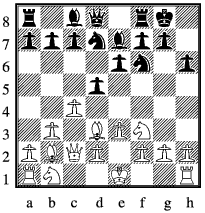
|
| RR v Gordon Parker after 7 ... Nbd7
|
r1bq1rk1/pppnbpp1/4pn1p/3p4/2P5/1P1BPN2/PBQP1PPP/RN2K2R w
8 Nc3 Nc5, 9 Be2 c6, 10 0-0 Re8, 11 d4 Nce4
12 Bd3 Nxc3, 13 Bxc3 Bd6, 14 Ne5 Bxe5, 15 dxe5 Nd7
16 f4 Nc5, 17 Rad1 RR would perhaps be better keeping the bishop on, but decided that centralising the rook against the queen cannot be bad, which indeed it isn't.
17 ... Nxd3, 18 Qxd3 Qb6, 19 Rf3 The sort of dual purpose move one would like to be able to play more often - defending the e-pawn and getting ready to swing onto the g or h files to support a frontal assault on the enemy monarch.
19 ... dxc4, 20 Qxc4 Rd8, 21 Rd6 diagram right
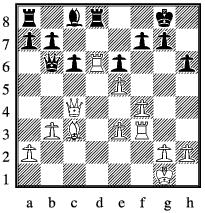
|
| RR v Gordon Parker after 21 Rd6
|
r1br2k1/pp3pp1/1qpRp2p/4P3/2Q2P2/1PB1PR2/P5PP/6K1 b
Material still equal, but surely this is a winning position. Black can only remove my rook at the expense of re-opening the a1h8 diagonal for my bishop. Meanwhile his queen is tied to the defence of his rook, and he still has the more than minor problem of activating his bishop, which currently is doing an excellent job keeping his queen's rook out of the game. White's army on the other hand has almost the freedom of the board.
21 ... Rxd6, 22 exd6 c5, 23 Qd3 Bd7, 24 Rg3
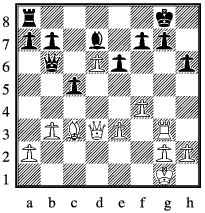
|
| RR v Gordon Parker after 24 Rg3
|
r5k1/pp1b1pp1/1q1Pp2p/2p5/5P2/1PBQP1R1/P5PP/6K1 b
Things are looking really ugly for black. g6 loses quickly to Rxg6+, f6 to Bxf6. f5 keeps the queen out of the attack, but allows Rxg7+.
24 ... g5, 25 fxg5 h5, 26 Bf6 Not best. Intended as a way of keeping the king trapped by preventing the f-pawn moving, but coming down the h-file with Rh3 must lead to mate, mustn't it?.
Also good must be 26 g6 f6/f5, 27 Qd1
26 ... Qb4, 27 Qc3 Switching into a boring pragmatic mode. Objectively the exchange of queens relieves a lot of pressure, but I'm now homing in on a relatively straightforward endgame win.
27 ... Qxc3, 28 Bxc3 Kh7, 29 Rf3 threatening Rf6, Rh6 and Rh8 mate.
29 ... Kg6, 30 h4 1-0
Clearly Gordon didn't fancy playing an endgame two pawns down after f5 and the en passant capture. Certainly I feel that my pawns are sufficiently well placed that I could afford to reach an opposite coloured bishops ending. Although I didn't find the clean kills that were there I'm still pleased that once ahead I never allowed Gordon back into the game.
comment on this article
Wed 13th: BTTER I
It is well known that winning won games is difficult. At least as hard can be saving lost ones. You may argue that if a game is lost then by definition it cannot be saved, but what I'm writing about here is the art of hanging in until your opponent gives you a chance to equalise or otherwise evade his clutches, and then taking advantage of said opportunity. Apart from early resigners we are all quite good at the hanging in bit, its noticing and exploiting the chance(s) your opponent gives that is so difficult. I call this Blind To The Escape Route, or BTTER. feel free to pronounce this "batter" in recognition of the resulting afinity your head has for brick walls, "better" as an exhortation to play so, "bitter" to denote your innermost feelings, "butter" as it was your fingers that made the moves, or even "botter" because you are after all different.
Pure Btter is quite rare, if only because of our opponents annoying habit of keeping their foot on our throats when they have us down. And in the case of early resigners, the custom of resigning when down. However by stretching the concept slightly examples are relatively easy to find.
Exhibit A comes from RR in action against Steve Hill of Meir.

|
| Steve Hill v RR after 12 Nf3-e5
|
rn1q1rk1/4bppp/1p2bn2/p1ppN3/3P4/PPNBP3/3B1PPP/R2Q1RK1 b
Twelve moves in and Steve has maintained white's natural edge, but has not been able to build on it. RR spots the natural Nfd7 preventing the white knight from living long on e5, but everkeen to develop more material came up with Nbd7. The uncomfortable (for RR) continuation was
13 Nc6 Qe8 (defend the bishop)
14 Nb5 Rc8 (spotting the coming fork)
15 Nca7 Rb8, 16 Nc7 Qd7, 17 Nxe6 fxe6, 18 Nc6 winning the exchange. As is his wont, RR struggled on for the best part of another 20 moves, there was no way back. Chalk up one to the bad guys.
After 12 ... Nbd7 the game isn't lost, but it felt that way with the white knights jumping around. Nevertheless RR failed to find the escape to quiter waters. His move 14 was a classic Btter move, for Nb8 prevents the fork on c7 on pain of losing both knights for the rooks, the exact idea that RR thought he had been looking for! After Nb8 white is still better, but it is not a winning edge.
comment on this article
Fri 15th: BTTER II
Another game, another dose of btter. RR is black again, this time against Matthew Wyza of Cheddleton. We join the game after Matthew blunders a pawn on move 17, RR already having had a positional edge. The two together must leave RR with a win. Now to win it.
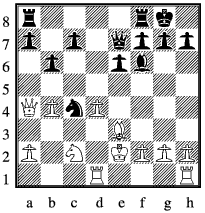
|
| Matthew Wyza v RR after 17 ... Na5xc4
|
r4rk1/p1p1qppp/1p2pb2/8/QPnP4/4B3/P1N1KPPP/3R3R w
18 Qb3 Nd6, 19 Rhe1 Qd7, 20 a4 c6, 21 Kf1 Nf5, 22 Rd3 Qd5
23 Qc3 Nh4, 24 f3 Rac8, 25 Bf2 Nf5, 26 Ne3 Nxe3+, 27 Bxe3 Rfd8
28 Rc1 Diagram right.
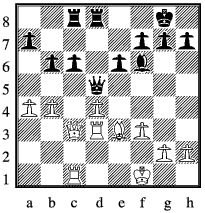
|
| Matthew Wyza v RR after 28 Rc1
|
2rr2k1/p4ppp/1pp1pb2/3q4/PP1P4/2QRBP2/6PP/2R2K2 w
Despite the minor kingside threats RR was always planning to take advantage of white's isolated d-pawn. He wants to play c5 here, but lacks the courage as there are too many variations for his poor brain to track, so simply decides to guard against back row mates.
28 ... h6, 29 Qc2 e5 (c5 is still the better undermining move)
30 Rcd1 e4 Inferior to exd4 when white would have the choice of conceding pawn and two rooks for queen or allowing c5 to create a supported passed pawn.
31 fxe4 Qxe4, 32 Qc4 Rd5 again failing to play c5 although it was RR's gut reaction move. Instead he tried to be too careful.
33 Kg1 Bg5, 34 Re1 Rf5, 35 Bf2 Qd5
36 Qa6 Qd7, 37 Rc3 Bd2 0-1
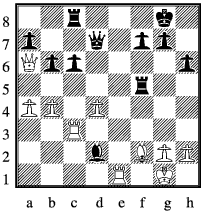
|
| Matthew Wyza v RR after 37 ... Bd2
|
2r3k1/p2q1pp1/Qpp4p/5r2/PP1P4/2R5/3b1BPP/4R1K1 w
Matthew resigns in his best position since he dropped the pawn.
38 Re7 Qd8 (... Qxe7, 39 Qxd8+ Qf8, 40 Rxc6 gets the pawn back)
39 Rc4 and the rooks escape the fork and black has been pushed backwards. Maybe not a true case of btter as the game is not yet saved, but the positional deficit is much reduced.
comment on this article
Tues 19th: BTTER III
Off to Alsager for a semi-final match in the Open Cup. RR finds himself black against Steve Brown. We join the game with RR considering his ninth move in reply to Steve's development of his dark squared bishop on g5.
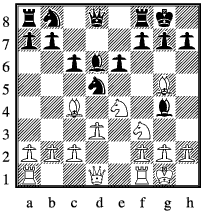
|
| Steve Brown v RR after 9 Bg5
|
rn1q1rk1/pp3ppp/2pbp3/3n2B1/2B1N1b1/3P1N2/PPP2PPP/R2Q1RK1 b
Be7 seems natural and safe, but mostly I'm trying to play a little more aggresively, so I nudge the f-pawn, which is of course much more commital in terms of future pawn structures.
9 ... f6, 10 Bh4 b5, 11 Bb3 a5, 12 a3 Na6 Knight on the rim may be dim, but decided he was on the rim on b8 anyway. At least it clears my back rank for the major pieces.
13 Bg3 Bxg3, 14 Nxg3 Nc5, 15 Ba2 f5 He's not going to get a knight into the hole I'm creating on e5 any time soon. Meanwhile perhaps I can use f6 to swing the rook into a kingside attack.
16 h3 Not unexpected, but still annoying that I'm going to have to exchange my bishop.
16 ... Bxf3, 17 Qxf3 Diagram right
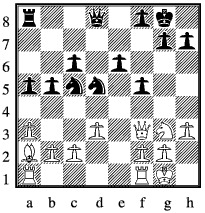
|
| Steve Brown v RR after 17 Qxf3
|
r2q1rk1/6pp/2p1p3/ppnn1p2/8/P2P1QNP/BPP2PP1/R4RK1 b
Space advantages are all well and good, but in creating them one can often end up with a slightly loose position. There is so much I would like to do here. Back to the rim with Na5 hitting the b-pawn has attractions as white cannot seriously play b3 to dislodge it - it simply jumps into c3 attacking the bishop and holding back the c-pawn. Kh8 gets the king off the same diagonal as his bishop releases pressure on my e-pawn which may then be able to advance away from its current backward state. Rf6 for the aforementioned kingside activity, and also providing some protection for my e-pawn which must surely come under attack. Even considered launching the g-pawn into action. Eventually came up with Qd6, connecting rooks, initial protection for the e-pawn and latent threats on h2.
17 ... Qd6, 18 d4 Nd7 So much for earlier aggressive intentions. Once forced to move the knight is surely better going to a5.
19 Rfe1 Rf6, 20 Nh5 Rh6, 21 Qg3 Qxg3, 22 Nxg3 g5 Not bad in itself, but I think I should be worrying more about the consequences of c4, which I'd be forced to take for
23 c4 N any, 24 cxb5 cxb5, 25 Nxf5 with the e-pawn pinned is clearly not good. A clear case of not being able to work out how attacking to be - I seem to change my mind almost on a move by move basis.
23 Rac1 Kf7, 24 c4 bxc4, 25 Rxc4
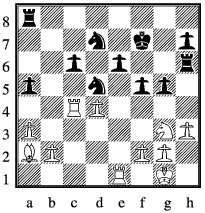
|
| Steve Brown v RR after 25 Rxc4
|
r7/3n1k1p/2p1p2r/p2n1pp1/2RP4/P5NP/BP3PP1/4R1K1 b
My pawn structure is not a thing of great beauty. Two isolated pawns and one backward one gives me plenty to keep my eyes on. Could be some grovelling o be done. I'd like to play Rb8 here to see whether he'll defend it or even better push it to b3, but unfortunately it just loses a pawn as
25 ... Rb7, 26 Rxc6 Rxb2, 27 Bxd5 and the e-pawn is pinned sideways and under attack by three pieces. Horrendous.
25 ... Ra6, 26 Rec1 Ne7 (Rh4 better, but my sudden defensive mentality meant I overlooked the possibility completely.)
27 Nf1 f4 Not good. Partially activating a rook with Rb6 or Rh4 must be better. Yes there is a minor cramping effect, it shoves a pawn closer to his king, and frees up f5 for a knight should one be freed from defensive duties, but all these are surely too long term for the rather more urgent needs of the current position.
28 Nh2= Oh Bother. He's offered me a draw and I reckon I'm losing. Not too much has happened elsewhere, but as one of only three of the eight team members to outgrade his opponent I'm not happy about abandoning responsibility for the match onto others shoulders.
28 ... Rf6, 29 Bb1 Kg7, 30 Ng4 Rf7 How do you work out whether f7, a dangerously white square (think his bishop), but sideways protecting material, or f8, a safe but unhelpful dark square, is the better retreat?
31 Re1 h5, 32 Ne5 Nxe5, 33 Rxe5 Kf6, 34 Bc2 Nd5 A more central square cannot be bad; more importantly ithe knight here is cutting the e-rook off from the queenside.
35 Ba4 Rc7 Rb7 probably better as it forces white to make a decision.
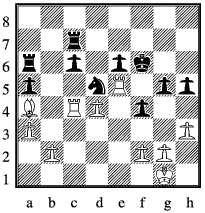
|
| Steve Brown v RR after 35 ... Rc7
|
8/2r5/r1p1pk2/p2nR1pp/B1RP1p2/P6P/1P3PP1/6K1 w
36 h4 A dastardly switch of attention to the kingside. Material loss for RR is guaranteed.
36 ... gxh4, 37 Rxh5 f3 If nothing else I'll open up the pawns in front of his king.
38 Rxh4 fxg2, 39 Rg4 Rb6, 40 b3 Kf5, 41 Rxg2 Nf4, 42 Rh2 Kg4 This could be king up to get mated rather than king up for the endgame, but what else doesn't involve just sitting waiting to be beaten?
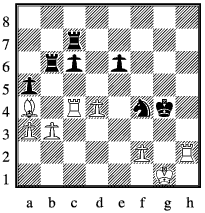
|
Steve Brown v RR after 42 ... Kg4
8/2r5/1rp1p3/p7/B1RP1nk1/PP6/5P1R/6K1 w
|
43 Kf1 Not going to allow any chances of knight forks then.
43 ... Rd7, 44 Bxc6 Rxb3 Hey! I',m threatening mate.
45 f3+ Kg3 Threatening the rook, and mate.
46 Rhc2 Saving the rook and that mate threat, but ...
46 ... Rh7 ... like buses here comes another
47 Ke1 The King gets on his bike ...
47 ... Rh1+, 48 Kd2 ... but runs into hedges:
48 ... Rd3#
RR completes his escape to victory, so where was the btter? I'm afraid it was on Steve's part on move 45. Ke1 would have left RR with the option of exchanging a pair of rooks or leaving white in charge of the h-file, whilst Rh3 is an alternative that would have forced off rooks. OK he hadn't been on the defensive for ages, but it was a chance to escape from the gathering clouds.
And what about the match. We ended up on 3½ each watching Alan Thomason and Barry Jones scrambling around in time trouble. The Rook and pawn ending rapidly switched from a straightforward win for Barry to an even easier one for Alan. But the clock threatened to intervene, so they agreed a draw leaving us with a win on board count. Can't help being clairvoyant - knew I needed to turn down that draw offer. (Ducks.)
comment on this article
Wed 27th: For Whom A Bell Tolls
Colin Abell is one of those players who I have seen around for years, but never played. Tonight RR gets to rectify that omission. We join the game with RR, black, having just castled.
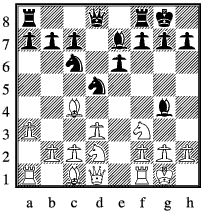
|
| Colin Abell v RR after 8 ... 0-0
|
r2q1rk1/ppp1bppp/2n1p3/3n4/2B3b1/P2P1N2/1PPN1PPP/R1BQ1RK1 w
9 Ba2 An unexpected voluntary retreat. c3 seems more natural
9 ... Nf4 Don't really know where this is going (g6?), but if it encourages him to move the d2 knight it will weaken his f3 one.
10 Kh1 By now you are getting the idea that chess players move in mysterious ways
10 ... a5 Talking of mysterious moves, what's this about? Vague ideas of a4 and swinging the queen's rook to the kingside via a5. But vague really is not good enough.
11 Ne4 Bd6, 12 Nxd6 Qxd6, 13 Bxf4 Qxf4, 14 Qd2 Qf6 15 Qc3
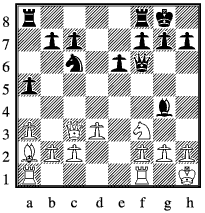
|
| Colin Abell v RR after 15 Qc3
|
r4rk1/1pp2ppp/2n1pq2/p7/6b1/P1QP1N2/BPP2PPP/R4R1K b
Decisions, decisions:
- Keep everything on
- Remove queens, but retain minor pieces so that I have superior pawns
- Remove queens and minor pieces, messing up pawns on both sides of boards but allowing him a half-open g-file to attack down
- Win a pawn at the expense of having my own pawns disrupted
RR chooses the material gain.
15 ... Bxf3, 16 Qxf6 Bxg2+, 17 Kxg2 gxf6, 18 Rg1 Rad8, 19 Kh1+ Kh8
20 Rad1 Rd4 21 c3 Rh4 Hated this move. Colin has a chance to shove his d-pawn hard. Rf4 would have given him something to defend, and so buy me time to prepare for the central pawn advance.
22 d4 Nd8, 23 Rd3 Going for a doubled rook attack on the g-file rather than the central shove. Not liking the idea of Rdg3, Rg7 and Bb1, RR chooses
23 ... Rg8, 24 Rdg3 Rg6, 25 Bb1 f5, 26 Bd3 c6 leaving a silly looking knight, but stopping his d-pawn going rogue on me
27 b4 That's annoying. Pause for thought. Time for my king to take a trip.
27 ... axb4, 28 axb4 Kg7, 29 Ra1 Kf6, 30 Ra8 Ke7, 31 Ra7 Now wanted to play Rgh6, but all I could see was
31 ... Rgh6, 32 Rg8 Rxh2+ followed by checks along the h-file with the white king staying on the g-file. White would then be threatening Ra8 to win the knight. Inadequate analysis as I can play
31 ... Rgh6, 32 Rg8 Rxh2+, 33 Kg1 Rh1+, 34 Rc1 and my rooks get to be a nuisance first.
31 ... Kd6, 32 Ra8 Kc7, 33 Ra2 Rf4, 34 Kg2 f6 Finally RR gets to roll some pawns, releasing his knight.
35 h3 e5, 36 Rxg6 Don't mind if you do. Perhaps Colin is running out of ideas.
36 ... hxg6, 37 Kg3 g5, 38 Re2 e4 0-1
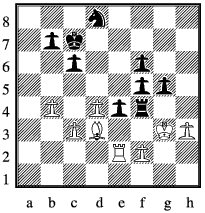
|
| Colin Abell v RR Final position
|
3n4/1pk5/2p2p2/5pp1/1P1Ppr2/2PB2KP/4RP2/8 w
comment on this article
Thurs 28th: See-saw
Off to Holmes Chapel to play the Kings in division one. RR is board four, so for the fourth time in five February games he gets black, this time against Andy Raeburn.
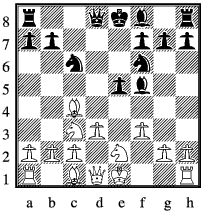
|
| Andy Raeburn v RR after 9 d3
|
r2qkb1r/pp3ppp/2n2n2/4pb2/2B5/2NP1P2/PPP1N1PP/R1BQK2R b
We join the game after white's ninth move. RR has a space advantage for his gambit opening. However although RR's pieces are currently slightly more actively placed e4 is a strong square for white, who has Na4 available should black attempt to stop him castling with Bc5 or Qb6, whilst Bg5 can also be annoying. Methinks I've lost the opening. But playing h6 or Be7 after giving a pawn both seem too slow, so
9 ... Bb4, 10 Bd2 0-0, 11 Ng3 Bg6, 12 Nge4 Na5 Another dim knight variation, but I may wish to launch my f-pawn so getting rid of his light-squared bishop would help.
13 Nxf6+ gxf6 Had a sudden panic about Nd5 rather than Ne4 from Andy, but
13 ... Qxf6, 14 Nd5 Qh4+, 15 g3 Bxd2+ or
14 ... Bxd2+, 15 Qxd2 Qd8 takes care of that. Thus gxf6 was miscalculation rather than attempt to be clever. Fortunately he is unlikely to want to castle long into a minority attack, so my kingside is not as vulnerable as it might otherwise be.
14 Bb3 a6 Not a move I'm proud of, but if I'm to open the a-file ant want to move my a-rook the move can't be all bad.
15 Ne4 Nxb3, 16 axb3 Be7 So I'm still a pawn down, but have the bishop pair on an open board. Worth something?
17 0-0
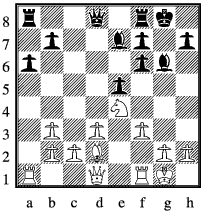
|
| Andy Raeburn v RR after 17 0-0
|
r2q1rk1/1p2bp1p/p4pb1/4p3/4N3/1P1P1P2/1PPB2PP/R2Q1RK1 b
Pleased to see him castle rather than launch his h-pawn at me. Now I get to shove pawns first.
17 ... f5, 18 Nf2 Rc8, 19 Bc3 f6, 20 Qe2 Bd6 with vague plans of Rf7, Qf8, Qh6 and e4, or Qc7 and e4. Trouble is by then Andy will have done something I need to reply to.
21 Ra4 Qe7, 22 d4 With all his major pieces on white squares, I suddenly feel happier.
22 ... Be8, 23 Raa1 Bb5, 24 Nd3 Now I can get the pawn back with
24 ... exd4, 25 Qxe7 Bxe7, 26 Bxd4 Rxc2 but then what? Instead I go for a passed pawn.
24 ... e4, 25 fxe4 Qxe4 Lacking the courage to allow Qg5 check. beginning to regret e4.
26 Qf3 Now I suspect Bxd3 and a game of doubled pawns is best, but leaving queens on must give more chances for errors or complications.
26 ... Bc6 27 Qxe4 fxe4 RR gets his passed pawn, but does it have a future?
28 Nf4 Rf7, 29 Nh5 f5
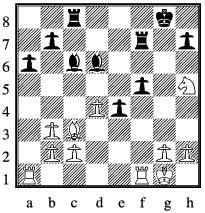
|
| Andy Raeburn v RR after 29 ...f5
|
2r3k1/1p3r1p/p1bb4/5p1N/3Pp3/1PB5/1PP3PP/R4RK1 w
30 d5 I'm not taking that, but I like the diagonals behind it for my bishops.
30 ... Bb5, 31 Rfe1 Bc5+, 32 Kh1 Bf2, 33 Red1 Be2 Careless. e3 first.
34 Nf6+ Rxf6, 35 Bxf6 Bxd1, 36 Rxd1 Kf7, 37 Bc3 the exchange sac on c3 now looks enticing - he'll end up with 6 pawns against my bishop and four, and I should be able to handle that. But I'll go for the pawn push instead - I'm sure someone said passed pawns should be pushed.
37 ... e3, 38 Be1 Rxc2, 39 Bxf2 Rxf2
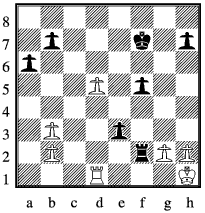
|
| Andy Raeburn v RR after 39 ... Rxf2
|
8/1p3k1p/p7/3P1p2/8/1P2p3/1P3rPP/3R3K w
Material equality now established, but the relative positions of our kings means my passed pawn is better than his, as is the rest of my pawn structure. Come on RR, you can do it.
40 Re1 f4 No! the f-pawn is now too far from the king. The e-pawn is not yet under real attack, so take the b2 pawn, and then the b3 one to protect the e-pawn as Rxe3 currently leaves a back row mate on. The queenside pawns would now come into the game with a vengeance.
41 Kg1 Rxb2, 42 Rf1 Rxb3, 43 Rxf4+ Ke7, 44 Kf1 Kd6, 45 Rh4 a5
46 Rxh7 a4, 47 Rh8 Kxd5, 48 Ke2 a3, 49 Ra8 b5, 50 h4 b4
51 h5 Rb2+, 52 Kxe3 Rxg2, 53 h6 Rh2, 54 Kd3
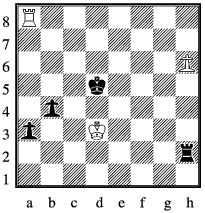
|
| Andy Raeburn v RR after 54 Kd3
|
R7/8/7P/3k4/1p6/p2K4/7r/8 b
54 ... Rxh6 Clang! 54 ... Rh3+, 55 Kd2 allows Kc4 whilst 55 Kc2 allows b3+ and b2. The only good news is that time is on my side and Andy may not have enough left to mop up my pawns and deliver mate.
55 Ra5+ Kc6, 56 Ra6+ Kb5, 57 Rxh6 a2, 58 Rh1 Ka4, 59 Kc4 Counter-Clang! Kc2 wins, but now we are heading for a draw. Look out for lines in which black queens only to lose the queen to a skewer or gets mated.
59 ... Ka3, 60 Rh8 b3, 61 Rh1 (not Kc3 a1Q+) b2
62 Rh3+ Ka4, 63 Rh8 Ka5, 64 Ra8+ Kb6, 65 Rb8+ Kc7
66 Rxb2 a1Q 67 Kb3 Kd6 68 Ra2 Qd1+ 69 Rc2 0-1
Andy's flag falls before we have time to discover whether RR has the technique to win the ending. Or is it one on the QvR positions that can be drawn. Must have a good delve sometime.
comment on this article




















